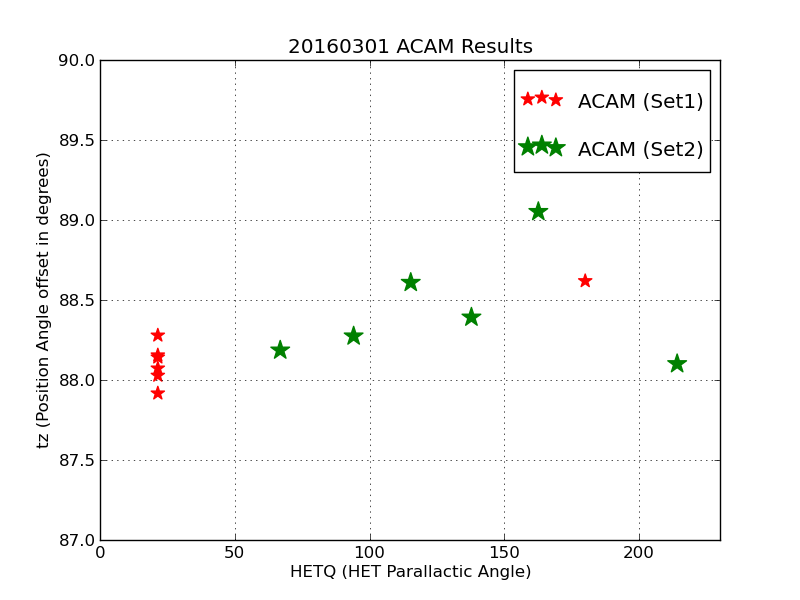 |
| Here is the plot I made for my data collected with WCS reductions of ACAM image taken with the HET on the night of 20160301 (UT). |
Using my output from RUN_STATS, I can make a Table file:
% cat Table.1
col01 = RMS, combined Ra,Dec residual rms in arcsec
col02 = tz, tz = Acam_PosAngle - HETQ (degrees)
col03 = plate scale (arcsec/pixel_)
col04 = HETQ, HET parallactic angle
col05 = image name
RMS tz ps HETQ Image
# data
0.268 88.619 0.26947 180.000 20160301T023620.4_acm_sci.fits
0.006 88.142 0.27072 21.452 20160301T030347.7_acm_sci.fits
0.339 87.917 0.27156 21.452 20160301T031055.4_acm_sci.fits
0.496 88.028 0.27109 21.452 20160301T031747.2_acm_sci.fits
0.210 88.073 0.27105 21.452 20160301T032232.1_acm_sci.fits
0.354 88.155 0.27009 21.452 20160301T032733.5_acm_sci.fits
0.292 88.279 0.27213 21.452 20160301T033146.9_acm_sci.fits
0.343 88.186 0.27051 66.856 20160301T034459.0_acm_sci.fits
0.502 88.274 0.27211 94.089 20160301T035356.8_acm_sci.fits
0.520 88.609 0.27252 115.276 20160301T040708.6_acm_sci.fits
0.264 88.392 0.27085 137.787 20160301T041917.6_acm_sci.fits
0.006 89.052 0.26887 162.610 20160301T043419.8_acm_sci.fits
0.380 86.651 0.27047 189.374 20160301T044319.0_acm_sci.fits
0.546 88.101 0.27107 214.103 20160301T045456.8_acm_sci.fits
Suppose I want to plot tz as a function of HETQ?
% colget.py -h usage: colget.py [-h] [-v] arg1 arg2 arg3 positional arguments: arg1 Input table-style file arg2 Column number of data to be extracted arg3 Name of data column being extracted optional arguments: -h, --help show this help message and exit -v, --verbose Verbose responses
First I pull out the quantities I want and paste them into a single two column file. I look at my awk and sed notes to recall how the heck to do this!
% colget.py Table.1 2 tz Created list.tz with 14 lines % colget.py Table.1 4 HETQ Created list.HETQ with 14 lines % paste list.HETQ list.tz > big.2col % cat big.2col 180.000 88.619 21.452 88.142 21.452 87.917 21.452 88.028 21.452 88.073 21.452 88.155 21.452 88.279 66.856 88.186 94.089 88.274 115.276 88.609 137.787 88.392 162.610 89.052 189.374 86.651 214.103 88.101Becasue I want to demo how I will plot multiple sets of data, I split my file big.2col into two files: f.1 and f.2. Then I slap the headers on that I need for running pxy_SM_scat.py to get my plot. I show my final files, the meta file I build manually (style.1), and the command line call to pxy_SM_scat.py I use to make the plot:
% cat f.1 r * 100 ACAM (Set1) 180.000 88.619 21.452 88.142 21.452 87.917 21.452 88.028 21.452 88.073 21.452 88.155 21.452 88.279 % cat f.2 g * 200 ACAM (Set2) 66.856 88.186 94.089 88.274 115.276 88.609 137.787 88.392 162.610 89.052 189.374 86.651 214.103 88.101 % cat style.1 ACAM Results HETQ (HET Parallactic Angle) tz (Position Angle offset in degrees) f.1 f.2 % pxy_SM_scat.py style.1 0 230 87 90Below I show the plot I made this way. I built the web figure using build_htm_img to make this figure.
 |
| Here is the plot I made for my data collected with WCS reductions of ACAM image taken with the HET on the night of 20160301 (UT). |